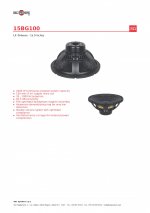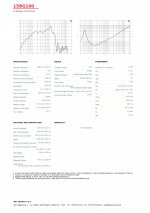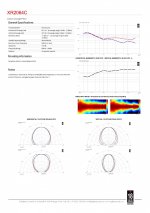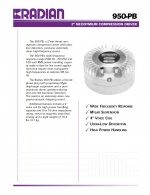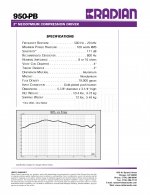Every sub I’ve modeled has higher excursion as sealed vs ported. The Td15m, ported, has the lowest excursion within the subbass of all AE subs I’ve modeled. Group delay is on par with The Td15h (ported)...else wise, all sealed subs obviously have way better group delay. What you say about that?
When you compare subs with two-way speakers then you are definitely doing an apple to oranges comparison. With a two-way it is definitley advisible to use bass-reflex in order to keep excursion low because of IMD and FMD. These two distortion types are less important with a pure sub that doesn't have to reproduce midrange frequencies. So it is either a two way with bass-reflex or a three way where the low-mid and sub are built as closed-box in order to keep group-delay distortion low.
Regards
Charles
These drivers and horns are 'save bets' tuyen. I am sure you'll like 'em even more, once you've optimized the system.
So let's take a closer look at Vance Dickason's far field monitor project.
Especially the woofer is a rather particular choice.
If you like energy storage, this is your driver!
Due to an ultra heavy cone (Mms: 240g !!!), sloppy NBR surround and subsequently a high compliance double spider, this driver needs a powerful motor structure.
It's a B&C, there are no doubts about the engineering of this "ScanSpeak HiFi woofer on steroids".
This driver is the opposite of what I consider sensible.
Because of this, it probably makes sense (again).
I couldn't find additional info on this far field project, so we'll have to guess.
One obvious clue is the designer, David Nelson of Triad loudspeakers.
If you check his website you'll find he's a proponent of sealed box designs.
In fact, I couldn't find any bas reflex design.
With this in mind and considering the B&C's 'physics', it's not surprising this driver is probably one of the best B&C 15" woofers for use in a SEALED cabinet.
IMO you'll have to be a closed box fetishist to use this driver and not really care about the midrange (where most of the music is).
Here's the paradox:
If you look at the response, the huge breakup spike at 1200Hz stands out.
Personally I wouldn't use this driver above 500Hz.
However, Mr. Dickason choose the XR2064C for horn duties. It's a nice horn, but not suitable for a crossover below 800Hz.
In order to make this combo work, you'll likely have to resort to 48dB slopes. I doubt the B&Cs midrange gets anywhere near the 15PR400's tranquility.
Finally, in box with some BSC applied, the B&C likely ends up with a sensitivity around 90dB.
Without doubt his monitor needs huge amounts of power in order to come to life.
Mr. Dickason is a knowledgable engineer, so his monitors will probably sound very nice in the end.
I wouldn't build a 2-way according to this design philosophy though. It's more akin to a scaled up typical HiFi 2-way.
In doing so, some of the merits of large highly efficient (low excursion) drivers are lost.
Especially the woofer is a rather particular choice.
If you like energy storage, this is your driver!
Due to an ultra heavy cone (Mms: 240g !!!), sloppy NBR surround and subsequently a high compliance double spider, this driver needs a powerful motor structure.
It's a B&C, there are no doubts about the engineering of this "ScanSpeak HiFi woofer on steroids".
This driver is the opposite of what I consider sensible.
Because of this, it probably makes sense (again).
I couldn't find additional info on this far field project, so we'll have to guess.
One obvious clue is the designer, David Nelson of Triad loudspeakers.
If you check his website you'll find he's a proponent of sealed box designs.
In fact, I couldn't find any bas reflex design.
With this in mind and considering the B&C's 'physics', it's not surprising this driver is probably one of the best B&C 15" woofers for use in a SEALED cabinet.
IMO you'll have to be a closed box fetishist to use this driver and not really care about the midrange (where most of the music is).
Here's the paradox:
If you look at the response, the huge breakup spike at 1200Hz stands out.
Personally I wouldn't use this driver above 500Hz.
However, Mr. Dickason choose the XR2064C for horn duties. It's a nice horn, but not suitable for a crossover below 800Hz.
In order to make this combo work, you'll likely have to resort to 48dB slopes. I doubt the B&Cs midrange gets anywhere near the 15PR400's tranquility.
Finally, in box with some BSC applied, the B&C likely ends up with a sensitivity around 90dB.
Without doubt his monitor needs huge amounts of power in order to come to life.
Mr. Dickason is a knowledgable engineer, so his monitors will probably sound very nice in the end.
I wouldn't build a 2-way according to this design philosophy though. It's more akin to a scaled up typical HiFi 2-way.
In doing so, some of the merits of large highly efficient (low excursion) drivers are lost.
Attachments
Last edited:
Here's the paradox:
If you look at the response, the huge breakup spike at 1200Hz stands out.
Personally I wouldn't use this driver above 500Hz.
However, Mr. Dickason choose the XR2064C for horn duties. It's a nice horn, but not suitable for a crossover below 800Hz.
In order to make this combo work, you'll likely have to resort to 48dB slopes.
Yeah, these huge peaks are out at the ~5th harmonic, so 36*2^5 = ~1152 Hz/12 dB = ~576 Hz/4th order plus parallel notch filter or 8th order to get close to the theoretical goal of > -25 dB, though considering its 'sprung like a buckboard' construction [tiny Vas] best suited for BLH apps, < ~288 Hz/4th order would be my choice and get a real mid bass [horn] driver.
GM
Last edited:
Thanks for backing me up on this, GM.
I didn't take a BLH into consideration for this driver.
Sometimes, it's better to reread before posting...
...." I doubt the B&Cs midrange gets anywhere near the 15PR400's tranquility."....
and transparency/openness.
I didn't take a BLH into consideration for this driver.
Sometimes, it's better to reread before posting...
...." I doubt the B&Cs midrange gets anywhere near the 15PR400's tranquility."....
and transparency/openness.
Last edited:
He could be venturing into new territory, finding things out the hard way?his monitors will probably sound very nice in the end.
That's doubtful, considering his level of knowledge and experience, even though his "Loudspeaker Design Cookbook" deals primarily with low sensitivity hifi loudspeakers.
It's probably a matter of design approach/philosophy.
It's probably a matter of design approach/philosophy.
Last edited:
The η₀ of 0.8% speaks for itself.
Ro808 what the heck is this..... I don’t even know how to make that character, but I really want to understand what you are talking about.
GM you didn’t engage my last response regarding polars, TMM, and frequency response in the near field =( I guess my responses must be on point and you’ve made your point clear that you are only in support of a MTM....I know you are right. It does seem that if we follow the 3+\- mm rule for Xmax that a dedicated subwoofer is a must.
Last edited:
Thanks for backing me up on this, GM.
I didn't take a BLH into consideration for this driver.
Sometimes, it's better to reread before posting...
...." I doubt the B&Cs midrange gets anywhere near the 15PR400's tranquility."....
and transparency/openness.
😀 When you're right, you're right!
Apparently doesn't help me much no matter how many times I [re]read/revise/correct my offline composed responses as way too many still need more once posted. 🙁
GM
I was considering that 15BG100 woofer a few years ago for a large three-way D'appolito. I guess when midrange is kept away from it it is a very nice driver.
regards
Charles
regards
Charles
GM you didn’t engage my last response regarding polars, TMM, and frequency response in the near field =( I guess my responses must be on point and you’ve made your point clear that you are only in support of a MTM....I know you are right. It does seem that if we follow the 3+\- mm rule for Xmax that a dedicated subwoofer is a must.
Why? Asked and answered by Dr. Geddes recently.
Re 'subwoofer'; needs to be plural, not just to help with room modes, but to get enough efficiency to match the MTM. Remember, for every doubling/halving of an octave is a 6 dB [4x] decrease/increase in sound power, so all else equal, dual mid bass/channel requires quad bass/channel and doubled again for VLF.
Normally, all else isn't equal and we have to trade efficiency for higher power handling woofers, but too many make the mistake of relying on one or two very high Xmax, multiple kW worth of power 'subs', which doesn't really blend well unless either TL/horn loaded and/or the XO is a lot lower than you plan, assuming sealed mid-bass.
GM
I was considering that 15BG100 woofer a few years ago for a large three-way D'appolito. I guess when midrange is kept away from it it is a very nice driver.
regards
Charles
Rather use the 15nbx100 in that case
Well, the 15nbx100 would be more efficient by 4 dB approx but the 15BG100 would go lower by almost an octave which isn't a disadvantage in a HiFi environment.
Regards
Charles
Regards
Charles
η0 is the reference, or power available efficiency of the driver in %:
(4 * Pi^2 / C^3 ) * (Fs^3 * VAS / Qes ) * 100
Which for the 15BG100 is: 0.768%
In comparison, the older 15PL40: 5.291%
It's apples and oranges though: a (sub)woofer versus an oldskool midwoofer.
(4 * Pi^2 / C^3 ) * (Fs^3 * VAS / Qes ) * 100
Which for the 15BG100 is: 0.768%
In comparison, the older 15PL40: 5.291%
It's apples and oranges though: a (sub)woofer versus an oldskool midwoofer.
Last edited:
Re 'subwoofer'; needs to be plural, not just to help with room modes, but to get enough efficiency to match the MTM. Remember, for every doubling/halving of an octave is a 6 dB [4x] decrease/increase in sound power, so all else equal, dual mid bass/channel requires quad bass/channel and doubled again for VLF.
Normally, all else isn't equal and we have to trade efficiency for higher power handling woofers, but too many make the mistake of relying on one or two very high Xmax, multiple kW worth of power 'subs', which doesn't really blend well unless either TL/horn loaded and/or the XO is a lot lower than you plan, assuming sealed mid-bass.
GM
Very clear and concise!
It's much easier and a hell of a lot cheaper as well to manage 35-40Hz (in room).
Last edited:
Some additional η0 values:
- Altec 416-8B: 3.492% - 3.632% (depending on revision)
- AE TD15M 8 Ohm: 3.621%
- B&C 15TBX100: 1.678 %
- B&C 15PLB76: 4.544%
- Faital 15PR400: 2.734%
- Faital 15FH500: 2.351%
- JBL 2216-ND1: 2.044 %
- JBL 2226H: 3.311%
- JBL E145: 4.404 %
- JBL D130 & K130: 6.853%
- My own SICA woofers: 3.604%.
- Altec 416-8B: 3.492% - 3.632% (depending on revision)
- AE TD15M 8 Ohm: 3.621%
- B&C 15TBX100: 1.678 %
- B&C 15PLB76: 4.544%
- Faital 15PR400: 2.734%
- Faital 15FH500: 2.351%
- JBL 2216-ND1: 2.044 %
- JBL 2226H: 3.311%
- JBL E145: 4.404 %
- JBL D130 & K130: 6.853%
- My own SICA woofers: 3.604%.
Some additional η0 values:
- Altec 416-8B: 3.492% - 3.632% (depending on revision)
- AE TD15M 8 Ohm: 3.621%
- B&C 15TBX100: 1.678 %
- B&C 15PLB76: 4.544%
- Faital 15PR400: 2.734%
- Faital 15FH500: 2.351%
- JBL 2216-ND1: 2.044 %
- JBL 2226H: 3.311%
- JBL E145: 4.404 %
- JBL D130 & K130: 6.853%
- My own SICA woofers: 3.604%.
Is higher or lower better?
Normally, all else isn't equal and we have to trade efficiency for higher power handling woofers, ...
GM
When one uses multiple subs this really isn't a tradeoff because you just add another sub. In my system there are six 12-15" woofers. Three are subs and three are the low end of the three mains. This really is the optimal solution to the low frequency problems in small rooms (room design being seriously important as someone pointed out.)
And a few exotics:
- Davis 38RCA15: 3.567 %
- SUPRAVOX 400-2000: 2.397%
- TAD TL-1602 A: 2.032%
- Vitavox 15/40: 5.386%.
- Davis 38RCA15: 3.567 %
- SUPRAVOX 400-2000: 2.397%
- TAD TL-1602 A: 2.032%
- Vitavox 15/40: 5.386%.
We know that lighter cones add efficiency, but they tend to "loose-it" faster and harder so they are hard to take up to 1 kHz. The heavier cone B&C are very well controlled in this region. And there is absolutely no way that one cannot use the frequency response at the high end of the woofer as part of the crossover. I don't like the low mass woofer cones.
- Home
- Loudspeakers
- Multi-Way
- Is it possible to cover the whole spectrum, high SPL, low distortion with a 2-way?
